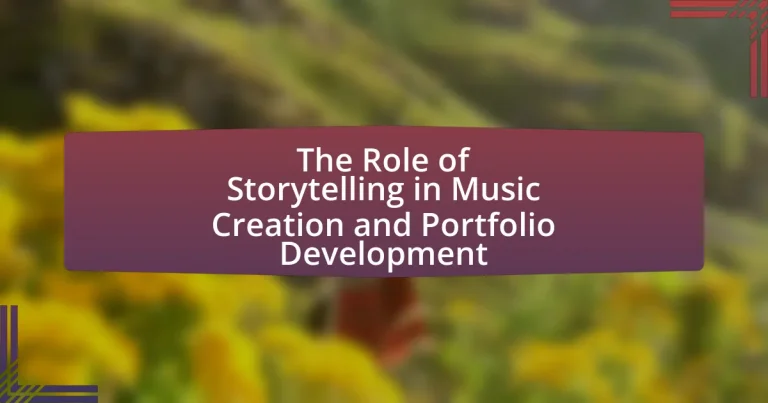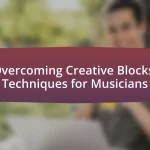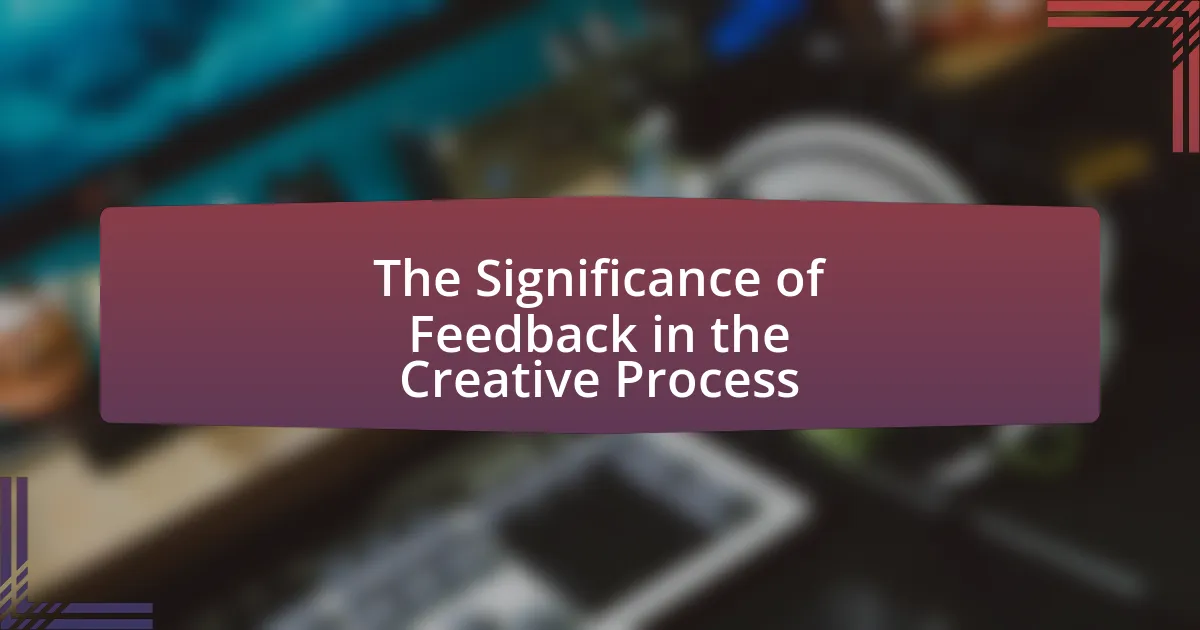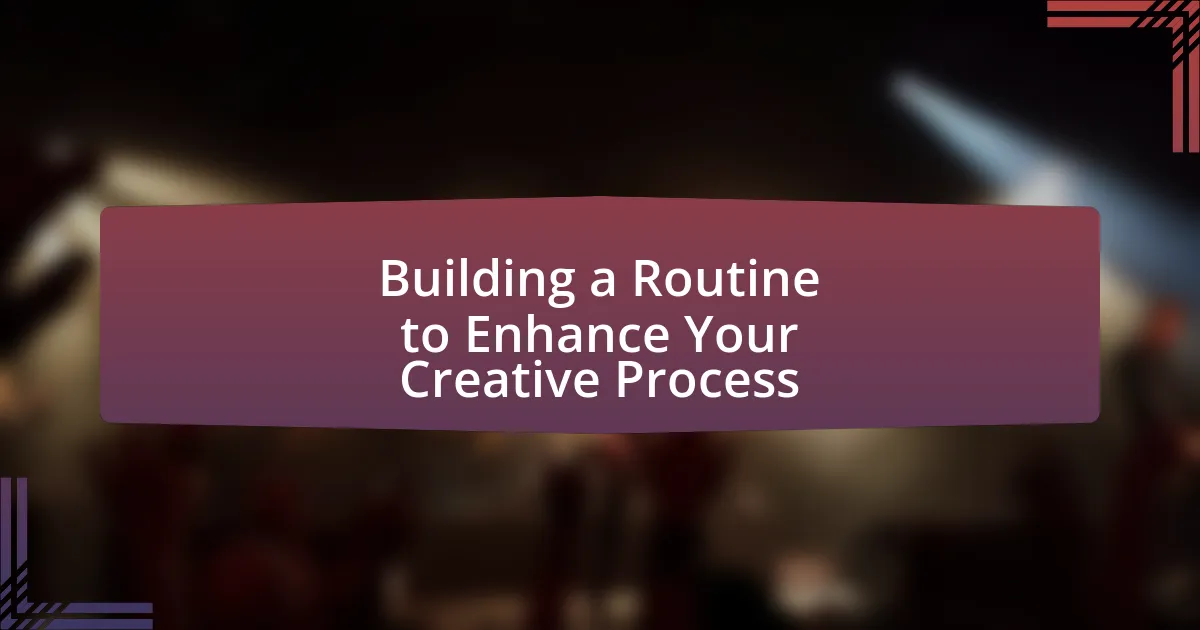The article examines the critical role of storytelling in music creation and portfolio development, emphasizing how narratives enhance emotional connections between artists and their audiences. It outlines the influence of storytelling on the songwriting process, highlighting essential elements such as character development, conflict, and resolution that contribute to lyrical depth. Additionally, the article discusses the psychological effects of storytelling on audience engagement, the importance of cohesive narratives in a musician’s portfolio, and best practices for integrating storytelling into music and promotional materials. By exploring these aspects, the article underscores the significance of authentic narratives in shaping an artist’s identity and fostering lasting connections with listeners.
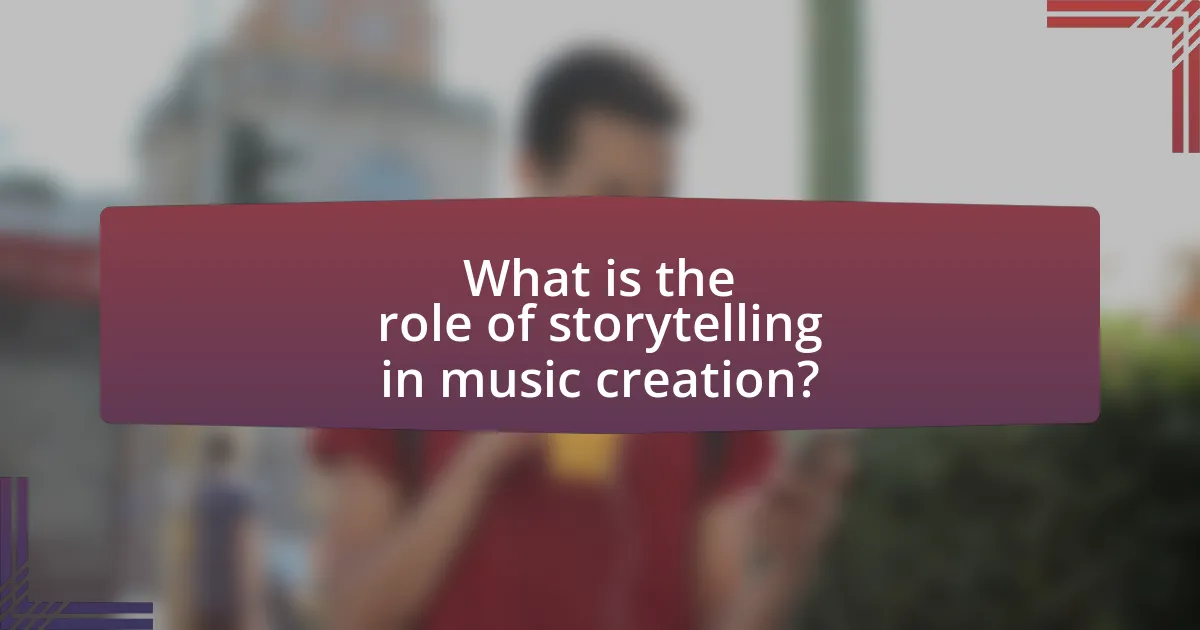
What is the role of storytelling in music creation?
Storytelling plays a crucial role in music creation by providing a narrative framework that enhances emotional connection and engagement with the audience. Through lyrics, melodies, and arrangements, musicians convey experiences, emotions, and messages that resonate with listeners, making the music more relatable and impactful. For instance, songs like Bob Dylan’s “The Times They Are a-Changin'” illustrate social change through storytelling, which not only captures the zeitgeist but also influences cultural movements. This narrative aspect helps artists establish their identity and connect with their audience on a deeper level, ultimately enriching the listening experience and fostering a lasting bond between the creator and the listener.
How does storytelling influence the songwriting process?
Storytelling significantly influences the songwriting process by providing a structured narrative that guides the creation of lyrics and melodies. This narrative framework helps songwriters convey emotions and experiences, making their music relatable and engaging. For instance, many successful songs, such as Bob Dylan’s “Tangled Up in Blue,” utilize storytelling techniques to weave complex narratives that resonate with listeners. Research indicates that songs with clear storytelling elements often achieve higher emotional impact and listener retention, as they create vivid imagery and connections to personal experiences. Thus, storytelling serves as a crucial tool in enhancing the depth and appeal of songwriting.
What elements of storytelling are essential in songwriting?
Essential elements of storytelling in songwriting include character development, conflict, and resolution. Character development allows listeners to connect emotionally with the song, as they relate to the experiences and emotions of the characters. Conflict introduces tension and engages the audience, creating a narrative arc that keeps them invested. Resolution provides closure, allowing listeners to reflect on the journey presented in the song. These elements are supported by the fact that songs with strong narratives often resonate more deeply with audiences, as evidenced by the success of storytelling songs in various genres, such as folk and country music, where narrative-driven lyrics frequently dominate the charts.
How can narrative techniques enhance lyrical depth?
Narrative techniques enhance lyrical depth by providing a structured framework that allows for the exploration of complex themes and emotions. By employing elements such as character development, plot progression, and vivid imagery, songwriters can create a more immersive experience for listeners. For instance, the use of storytelling in songs like “The River” by Bruce Springsteen illustrates how a narrative arc can evoke empathy and connection, deepening the emotional impact of the lyrics. This approach not only enriches the lyrical content but also engages the audience on a personal level, making the music more relatable and memorable.
Why is storytelling important for emotional connection in music?
Storytelling is important for emotional connection in music because it allows artists to convey relatable experiences and emotions, fostering a deeper bond with listeners. When musicians weave narratives into their songs, they create a context that listeners can connect with, enhancing the emotional impact of the music. Research indicates that songs with strong storytelling elements can evoke more intense emotional responses, as evidenced by a study published in the journal “Psychology of Music,” which found that narratives in lyrics significantly increased listeners’ emotional engagement. This connection is crucial for artists aiming to resonate with their audience and build a loyal fan base.
How do stories in songs resonate with listeners?
Stories in songs resonate with listeners by evoking emotions and creating relatable experiences. When songwriters incorporate narratives, they often draw on universal themes such as love, loss, and triumph, which can mirror the listeners’ own life experiences. Research indicates that music with storytelling elements can enhance emotional engagement; for instance, a study published in the journal “Psychology of Music” found that songs with clear narratives significantly increased listeners’ emotional responses compared to those without. This connection fosters a sense of empathy and understanding, allowing listeners to feel seen and heard through the music.
What psychological effects does storytelling have on audience engagement?
Storytelling significantly enhances audience engagement by fostering emotional connections and increasing retention of information. When audiences are presented with narratives, they are more likely to empathize with characters and situations, which activates emotional responses in the brain, particularly in areas associated with empathy and emotional processing. Research indicates that stories can increase the likelihood of information being remembered by up to 22 times compared to facts presented alone, as demonstrated in a study published in the journal “Psychological Science” by Paul Zak, which found that storytelling triggers the release of oxytocin, a hormone linked to bonding and trust. This emotional engagement not only captivates the audience but also encourages them to share the story, further amplifying its reach and impact.
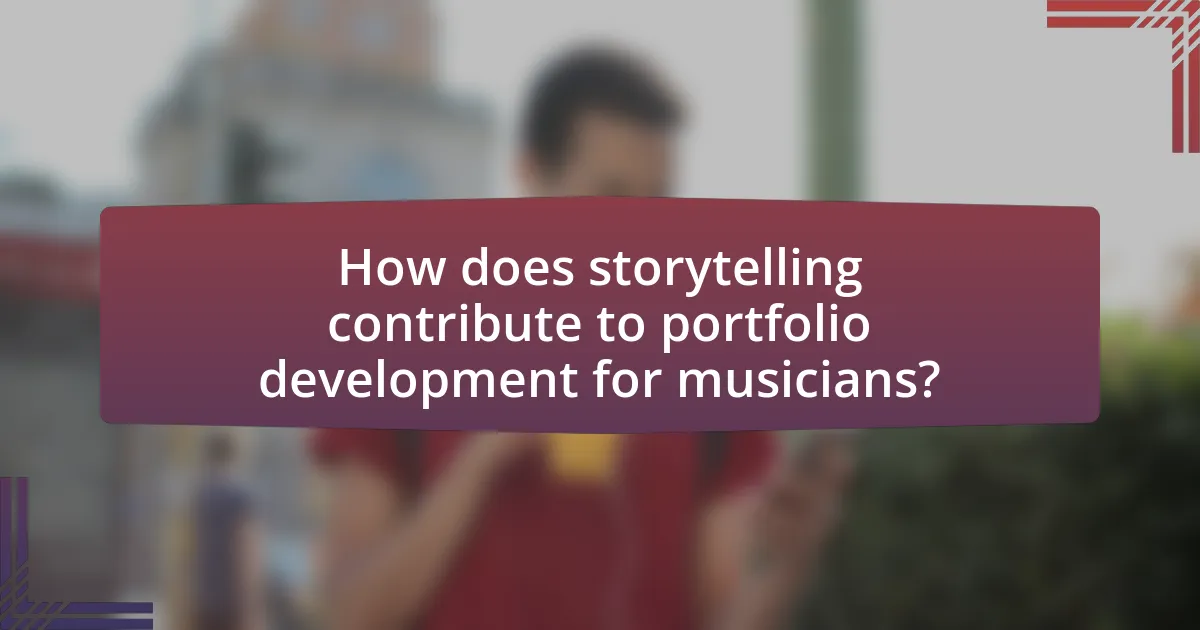
How does storytelling contribute to portfolio development for musicians?
Storytelling significantly enhances portfolio development for musicians by creating a deeper emotional connection with their audience. This connection is crucial as it allows musicians to convey their artistic vision and personal experiences through their work, making their portfolio more relatable and memorable. Research indicates that narratives can increase audience engagement by up to 65%, as stories evoke emotions that resonate with listeners. By integrating storytelling into their music and promotional materials, musicians can differentiate themselves in a competitive industry, showcasing not just their musical skills but also their unique perspectives and journeys. This multifaceted approach to portfolio development ultimately leads to stronger brand identity and increased opportunities for collaboration and performance.
What role does storytelling play in showcasing an artist’s identity?
Storytelling is essential in showcasing an artist’s identity as it provides a narrative framework that connects their personal experiences, values, and emotions to their creative work. This narrative allows audiences to understand the context behind the artist’s music, enhancing emotional engagement and relatability. For instance, artists like Taylor Swift use storytelling in their lyrics to reflect their life experiences, which not only defines their artistic persona but also resonates with fans on a personal level. This connection is supported by research indicating that storytelling in music can significantly influence listener perception and emotional response, thereby reinforcing the artist’s identity and brand.
How can personal narratives shape an artist’s brand?
Personal narratives shape an artist’s brand by creating a unique identity that resonates with audiences. When artists share their personal stories, they establish emotional connections, making their work more relatable and memorable. For instance, artists like Taylor Swift have effectively used their life experiences in their music, which has contributed to a loyal fan base and a distinct brand image. This connection is supported by research indicating that storytelling in branding can increase audience engagement by up to 300%, demonstrating the power of personal narratives in enhancing an artist’s market presence and authenticity.
What are effective ways to incorporate storytelling into a portfolio?
Effective ways to incorporate storytelling into a portfolio include using narrative-driven project descriptions, showcasing personal experiences related to each piece, and integrating multimedia elements that enhance the story. Narrative-driven project descriptions allow the audience to understand the context and inspiration behind the work, making it more relatable. Personal experiences create an emotional connection, as they provide insight into the creator’s journey and motivations. Additionally, multimedia elements such as images, videos, or audio clips can vividly illustrate the story, engaging the audience and enhancing their understanding of the work. These methods collectively create a cohesive narrative that resonates with viewers, making the portfolio more impactful.
Why is a cohesive narrative important in a musician’s portfolio?
A cohesive narrative is important in a musician’s portfolio because it creates a unified identity that resonates with audiences and industry professionals. This narrative helps to contextualize the musician’s work, making it more relatable and memorable. For instance, a study by the University of Southern California found that storytelling in artistic presentations significantly enhances audience engagement and emotional connection, which can lead to increased opportunities for collaboration and performance. By presenting a clear and compelling story, musicians can effectively communicate their artistic vision and differentiate themselves in a competitive market.
How does a strong narrative enhance the overall presentation of work?
A strong narrative enhances the overall presentation of work by creating a cohesive and engaging framework that connects various elements of the project. This connection allows the audience to understand the intent and emotional depth behind the work, making it more relatable and memorable. Research indicates that storytelling can increase audience retention of information by up to 65%, as narratives help to contextualize facts and evoke emotional responses. By weaving a compelling story throughout the presentation, creators can effectively highlight their artistic vision and the significance of their work, ultimately leading to a more impactful experience for the audience.
What are the risks of lacking a narrative in a portfolio?
Lacking a narrative in a portfolio poses significant risks, including diminished engagement and unclear messaging. Without a cohesive story, potential clients or employers may struggle to connect with the work, leading to a lack of interest or understanding of the creator’s vision and skills. Research indicates that storytelling enhances memory retention and emotional connection; for instance, a study by Paul Zak found that narratives can increase engagement by up to 65%. This suggests that portfolios without a narrative may fail to leave a lasting impression, ultimately reducing opportunities for collaboration or employment in the competitive music industry.

What are the best practices for integrating storytelling in music and portfolios?
The best practices for integrating storytelling in music and portfolios include creating a cohesive narrative that connects the music to the artist’s personal experiences and emotions. This approach enhances listener engagement and fosters a deeper connection with the audience. For instance, artists can use lyrics to convey personal stories or themes that resonate with their target demographic, thereby making the music more relatable. Additionally, visual elements in portfolios, such as images or videos, should complement the narrative, providing context and enhancing the overall storytelling experience. Research indicates that narratives in music can significantly increase emotional responses, as evidenced by a study published in the Journal of Experimental Psychology, which found that storytelling in songs leads to greater listener retention and emotional impact.
How can musicians develop their storytelling skills?
Musicians can develop their storytelling skills by actively engaging in writing exercises that focus on narrative structure and character development. This practice allows musicians to create compelling lyrics and melodies that resonate with listeners. Additionally, studying literature and film can provide insights into effective storytelling techniques, enhancing their ability to convey emotions and themes through music. Research indicates that musicians who incorporate storytelling elements into their work often achieve greater audience connection and emotional impact, as evidenced by the success of artists like Bob Dylan and Taylor Swift, who are known for their narrative-driven songs.
What exercises can help improve storytelling in songwriting?
To improve storytelling in songwriting, writers can engage in character development exercises. These exercises involve creating detailed profiles for characters, including their backgrounds, motivations, and conflicts, which helps in crafting relatable narratives. Research indicates that character-driven songs resonate more with audiences, as they evoke emotional connections and enhance the storytelling aspect. Additionally, practicing writing prompts that focus on specific scenarios or emotions can further refine a songwriter’s ability to convey a story effectively. This method encourages creativity and helps in structuring lyrics that tell a cohesive story.
How can collaboration enhance storytelling in music creation?
Collaboration enhances storytelling in music creation by bringing together diverse perspectives and experiences, which enrich the narrative depth of the music. When multiple artists collaborate, they can combine their unique backgrounds, ideas, and emotional insights, resulting in a more complex and relatable story. For instance, a study by the Berklee College of Music found that collaborative songwriting often leads to more innovative lyrical themes and melodies, as artists challenge each other’s creative boundaries. This synergy not only fosters creativity but also allows for a more nuanced exploration of themes, making the storytelling in music more impactful and engaging for listeners.
What common pitfalls should musicians avoid when using storytelling?
Musicians should avoid the pitfall of being overly complex in their storytelling, as it can confuse listeners and detract from the emotional impact of the music. Simplifying narratives allows for clearer communication of themes and emotions, which is essential for audience connection. Additionally, musicians should steer clear of clichés in their storytelling, as these can make their work feel unoriginal and uninspired. Originality in storytelling not only engages listeners but also distinguishes an artist in a crowded market. Lastly, musicians must not neglect the integration of their storytelling with the music itself; disjointed narratives can lead to a lack of coherence, diminishing the overall experience. Cohesion between lyrics and musical elements enhances the storytelling effect, making it more memorable and impactful.
How can clichés undermine the effectiveness of a story in music?
Clichés can undermine the effectiveness of a story in music by making the narrative predictable and unoriginal. When songwriters rely on overused phrases or themes, they fail to engage listeners, who may find the content lacking in emotional depth or authenticity. Research indicates that originality in storytelling enhances listener connection; for instance, a study published in the Journal of Creative Behavior found that unique narratives in music lead to higher listener engagement and emotional response. Thus, the reliance on clichés detracts from the potential impact of the story being told in a musical piece.
What strategies can help maintain authenticity in storytelling?
To maintain authenticity in storytelling, creators should prioritize personal experiences and emotions as the foundation of their narratives. By drawing from genuine life events, storytellers can create relatable and impactful stories that resonate with audiences. Research indicates that narratives rooted in personal truth foster deeper connections; for instance, a study published in the Journal of Communication found that stories based on real experiences are perceived as more credible and engaging. Additionally, maintaining a consistent voice and style throughout the storytelling process reinforces authenticity, as it allows the audience to connect with the storyteller’s unique perspective.
